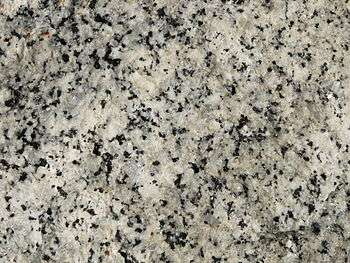Felsic
In geology, felsic is an adjective describing igneous rocks that are relatively rich in elements that form feldspar and quartz.[1] It is contrasted with mafic rocks, which are relatively richer in magnesium and iron. Felsic refers to silicate minerals, magma, and rocks which are enriched in the lighter elements such as silicon, oxygen, aluminium, sodium, and potassium. Felsic magma or lava is higher in viscosity than mafic magma/lava.
Felsic rocks are usually light in color and have specific gravities less than 3. The most common felsic rock is granite. Common felsic minerals include quartz, muscovite, orthoclase, and the sodium-rich plagioclase feldspars (albite-rich).
Terminology
In modern usage, the term acid rock, although sometimes used as a synonym, normally now refers specifically to a high-silica-content (greater than 63% SiO2 by weight) volcanic rock, such as rhyolite. Older, broader usage is now considered archaic. That usage, with the contrasting term "basic rock", was based on an incorrect idea, dating from the 19th century, that "silicic acid" was the chief form of silicon occurring in rocks.
The term "felsic" combines the words "feldspar" and "silica". The similarity of the resulting term felsic to the German felsig, "rocky" (from Fels, "rock"), is purely accidental. Feldspar is linked to German. It is a borrowing of Feldspat. The link is therefore to German Feld, meaning "field".[2]
Classification of felsic rocks

In order for a rock to be classified as felsic, it generally needs to contain more than 75% felsic minerals; namely quartz, orthoclase and plagioclase. Rocks with greater than 90% felsic minerals can also be called leucocratic,[3] from the Greek words for white and dominance.
Felsite is a petrologic field term used to refer to very fine-grained or aphanitic, light-colored volcanic rocks which might be later reclassified after a more detailed microscopic or chemical analysis.
In some cases, felsic volcanic rocks may contain phenocrysts of mafic minerals, usually hornblende, pyroxene or a feldspar mineral, and may need to be named after their phenocryst mineral, such as 'hornblende-bearing felsite'.
The chemical name of a felsic rock is given according to the TAS classification of Le Maitre (1975). However, this only applies to volcanic rocks. If the rock is analyzed and found to be felsic but is metamorphic and has no definite volcanic protolith, it may be sufficient to simply call it a 'felsic schist'. There are examples known of highly sheared granites which can be mistaken for rhyolites.
For phaneritic felsic rocks, the QAPF diagram should be used, and a name given according to the granite nomenclature. Often the species of mafic minerals is included in the name, for instance, hornblende-bearing granite, pyroxene tonalite or augite megacrystic monzonite, because the term "granite" already assumes content with feldspar and quartz.
The rock texture thus determines the basic name of a felsic rock.


| Rock texture | Name of felsic rock |
| Pegmatitic | Granite pegmatite |
| Coarse-grained (phaneritic) | Granite |
| Coarse-grained and porphyritic | Porphyritic granite |
| Fine-grained (aphanitic) | Rhyolite |
| Fine-grained and porphyritic | Porphyritic rhyolite |
| Pyroclastic | Rhyolitic tuff or breccia |
| Vesicular | Pumice |
| Amygdaloidal | None |
| Vitreous (Glassy) | Obsidian or porcellanite |
See also
Notes
- Marshak, Stephen, 2009, Essentials of Geology, W. W. Norton & Company, 3rd ed. ISBN 978-0393196566
- Harper, Douglas. "feldspar". Online Etymology Dictionary. Retrieved 2008-02-08.
- Aurora Geosciences Ltd. "TECHNICAL REPORT MACKENZIE MOUNTAINS IRON-COPPER PROPERTY, NORTHWEST TERRITORIES, CANADA" (PDF).
References
- Le Maitre, L. E., ed. 2002. Igneous Rocks: A Classification and Glossary of Terms 2nd edition, Cambridge